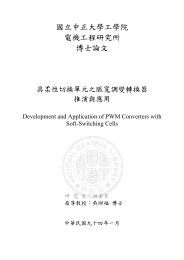Syntax of the Bi Comparative Construction in Mandarin Chinese
Syntax of the Bi Comparative Construction in Mandarin Chinese
Syntax of the Bi Comparative Construction in Mandarin Chinese
You also want an ePaper? Increase the reach of your titles
YUMPU automatically turns print PDFs into web optimized ePapers that Google loves.
<strong>Syntax</strong> <strong>of</strong> <strong>the</strong> <strong>Bi</strong> <strong>Comparative</strong> <strong>Construction</strong> <strong>in</strong> Mandar<strong>in</strong> Ch<strong>in</strong>ese<br />
behavior <strong>of</strong> <strong>the</strong> word bi, which is widely taken as <strong>the</strong> comparative marker, will be<br />
discussed firstly <strong>in</strong> 3.1. Base on <strong>the</strong> idea that bi is a complementizer that <strong>in</strong>troduces a<br />
comparative clause; we <strong>the</strong>n adopt <strong>the</strong> functional hypo<strong>the</strong>sis for <strong>the</strong> BCC structure.<br />
3.3 The Syntactic Properties <strong>of</strong> bi <strong>in</strong> <strong>Comparative</strong> <strong>Construction</strong>s<br />
Previous studies <strong>of</strong> BCC <strong>of</strong>ten start with classify<strong>in</strong>g <strong>the</strong> category <strong>of</strong> <strong>the</strong><br />
comparative morpheme bi, based on which <strong>the</strong>y try to study <strong>the</strong> syntactic structure. In<br />
this section, we exam<strong>in</strong>e <strong>the</strong> possible syntactic categories <strong>of</strong> bi, and <strong>the</strong>n propose that<br />
with some historical change, bi behaves more like a complementizer that <strong>in</strong>troduces<br />
<strong>the</strong> degree clause to adjo<strong>in</strong> as <strong>the</strong> datum <strong>of</strong> <strong>the</strong> comparison.<br />
3.2.1 bi As a Verb<br />
Orig<strong>in</strong>ally, bi has <strong>the</strong> mean<strong>in</strong>g <strong>of</strong> “compare” and “compete;” however, after long<br />
years <strong>of</strong> historical derivation, behaves quite differently <strong>in</strong> both context. Chao (1968)<br />
ma<strong>in</strong>ta<strong>in</strong>s that bi is always a verb and thus analyzes BCC as an <strong>in</strong>stance <strong>of</strong> serial verb<br />
construction (SVC). However, lots <strong>of</strong> syntactic evidence have been listed to manifest<br />
that bi <strong>in</strong> BCC does not behave like a verb (Hong 1991, Hs<strong>in</strong>g 2003). Though <strong>the</strong> verb<br />
bi ‘to compete’ and <strong>the</strong> comparative marker bi were historically related, <strong>the</strong>y are<br />
actually homophones today.<br />
First, aspect markers can be added to a verb like (71a), which is also feasible<br />
when bi is used as a verb (71b). However, <strong>the</strong>re is no way to add <strong>the</strong> aspect markers to<br />
<strong>the</strong> bi <strong>in</strong> <strong>the</strong> comparative construction (71c).<br />
(71) a. Laoli na le maoj<strong>in</strong> qu xizao. [SVC]<br />
Laoli take ASP towel go take a bath.<br />
‘Laoli took a towel to take a bath.’<br />
46<br />
中正大學 e-Thesys (94 學年度)





